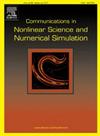利用对称差分数据增强物理信息神经网络预测Ablowitz-Ladik方程离散异常波解和模型参数
IF 3.4
2区 数学
Q1 MATHEMATICS, APPLIED
Communications in Nonlinear Science and Numerical Simulation
Pub Date : 2025-06-25
DOI:10.1016/j.cnsns.2025.109046
引用次数: 0
摘要
我们介绍了一种创新的离散深度学习方法,称为对称差分数据增强物理信息神经网络(sde - pinn),旨在解决非线性晶格方程中与离散异常波相关的正向和逆问题。该方法的特点是三个主要贡献:(1)开发了保持结构的离散差分算子,该算子在晶格系统中保持固有对称性,从而克服了传统连续pinn在应用于离散环境时的局限性;(2)据我们所知,这是第一次将深度学习技术应用于离散系统的逆问题,在稀疏、低噪声的数据条件下实现系数反演。此外,观察到增加数据密度可以增强对高噪声环境的鲁棒性;(3)综合统计非参数检验分析阐明了初始化策略与模型鲁棒性之间的重要关系,特别是确定了最优初始化点为真对称与域边界之间的中点。通过对Ablowitz-Ladik (AL)方程内一阶和二阶离散异常波的综合数值实验和参数反演,我们证明了该方法在正演模拟中达到10−4的精度水平,在反问题中参数识别率超过99%。这种方法独特地将深度学习与离散孤子理论相结合,在两个领域之间建立了新的联系。本文章由计算机程序翻译,如有差异,请以英文原文为准。
Prediction of discrete rogue wave solutions and model parameters of Ablowitz–Ladik equation via symmetric difference data enhancement physics-informed neural networks
We introduce an innovative discrete deep learning approach, termed symmetric difference data enhancement physics-informed neural networks (SDE-PINNs), designed to address both forward and inverse problems associated with discrete rogue waves in nonlinear lattice equations. The methodology is characterized by three main contributions: (1) The development of structure-preserving discrete difference operators that maintain intrinsic symmetry within lattice systems, thereby overcoming the limitations of traditional continuous PINNs when applied to discrete environments; (2) To the best of our knowledge, this is the first application of deep learning techniques to inverse problems in discrete systems, achieving coefficient inversion under sparse, low-noise data conditions. Additionally, it was observed that increasing data density enhances robustness against high-noise environments; (3) A comprehensive statistical non-parametric test analysis elucidates the crucial relationship between initialization strategies and model robustness, notably identifying the optimal initialization point as the midpoint between true symmetry and domain boundaries. Through comprehensive numerical experiments and parameter inversion applied to first- and second-order discrete rogue waves within the Ablowitz–Ladik (AL) equation, we demonstrate the method’s ability to attain accuracy levels of in forward modeling and a parameter recognition rate exceeding 99% in inverse problems. This approach uniquely integrates deep learning with discrete soliton theory, establishing novel connections between the two fields.
求助全文
通过发布文献求助,成功后即可免费获取论文全文。
去求助
来源期刊

Communications in Nonlinear Science and Numerical Simulation
MATHEMATICS, APPLIED-MATHEMATICS, INTERDISCIPLINARY APPLICATIONS
CiteScore
6.80
自引率
7.70%
发文量
378
审稿时长
78 days
期刊介绍:
The journal publishes original research findings on experimental observation, mathematical modeling, theoretical analysis and numerical simulation, for more accurate description, better prediction or novel application, of nonlinear phenomena in science and engineering. It offers a venue for researchers to make rapid exchange of ideas and techniques in nonlinear science and complexity.
The submission of manuscripts with cross-disciplinary approaches in nonlinear science and complexity is particularly encouraged.
Topics of interest:
Nonlinear differential or delay equations, Lie group analysis and asymptotic methods, Discontinuous systems, Fractals, Fractional calculus and dynamics, Nonlinear effects in quantum mechanics, Nonlinear stochastic processes, Experimental nonlinear science, Time-series and signal analysis, Computational methods and simulations in nonlinear science and engineering, Control of dynamical systems, Synchronization, Lyapunov analysis, High-dimensional chaos and turbulence, Chaos in Hamiltonian systems, Integrable systems and solitons, Collective behavior in many-body systems, Biological physics and networks, Nonlinear mechanical systems, Complex systems and complexity.
No length limitation for contributions is set, but only concisely written manuscripts are published. Brief papers are published on the basis of Rapid Communications. Discussions of previously published papers are welcome.
 求助内容:
求助内容: 应助结果提醒方式:
应助结果提醒方式:


